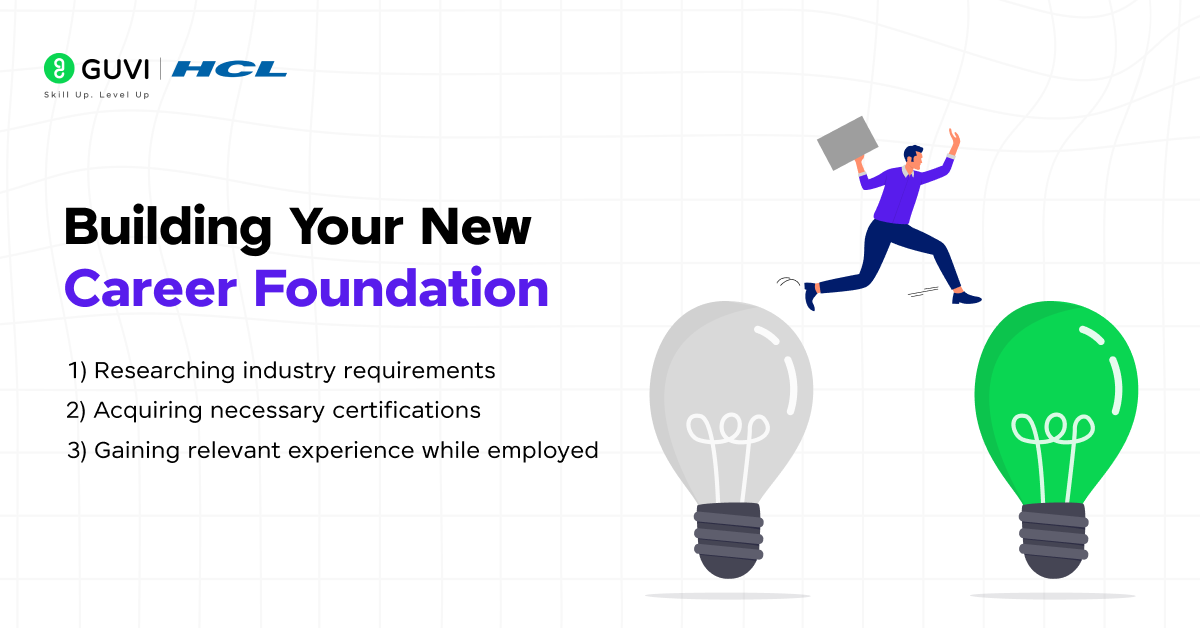
How to Successfully Change Careers at 30: A Step-by-Step Guide
Feb 04, 2025 6 Min Read 2311 Views
(Last Updated)
Do you feel stuck in a career that doesn’t excite you anymore? You’re not alone. Studies reveal that people change careers 5-7 times throughout their working life, and many make the most important switches around age 30.
Your thirties create the perfect balance of experience and adaptability for a career change. You understand workplace dynamics well enough, yet stay flexible enough to learn new skills and adapt to different industries.
This complete guide will help you navigate every step of your transition to change careers at 30. You’ll discover how to evaluate your current situation and execute your career change strategy effectively. The process works whether you want a total career switch or plan to start fresh without experience. You’ll learn exactly how to make your career change successfully while meeting your goals.
Table of contents
- Changing Careers at 30: Your Step-by-Step Guide
- Step 1) Assessing Your Current Career Situation
- Step 2) Understanding the Psychology of Career Change
- Step 3) Creating Your Career Transition Strategy
- Step 4) Identifying Your Transferable Skills
- Step 5) Building Your New Career Foundation
- Step 6) Executing Your Career Change Plan
- Takeaways…
- FAQs
- Q1. Is it too late to change careers at 30?
- Q2. How long does a career change typically take?
- Q3. What should I consider before changing careers?
- Q4. How can I overcome the fear of changing careers?
- Q5. How can I finance my career change?
Changing Careers at 30: Your Step-by-Step Guide
Changing careers at 30 can be a powerful step toward personal and professional fulfillment. With a decade of work experience, you bring transferable skills like problem-solving, adaptability, and communication, which are highly valued in any field. To make the transition easier for you, let’s break it down step-by-step.
Step 1) Assessing Your Current Career Situation
A full picture of your current situation should precede any major career switch at 30. You’re not alone in this decision – studies show 44% of professionals don’t feel satisfied with their career path options.

1.1) Signs it’s time for a career change
Your body and mind will tell you when you need a career change. Look out for these signs:
- Chronic stress and confidence issues: Your self-esteem suffers or you experience constant stress from work
- Lifestyle misalignment: The role you have now doesn’t fit your life priorities anymore
- Motivation decline: Latest surveys point out that feeling unchallenged and lack of participation are the main signs you need a career change
1.2) Evaluating your job vs career satisfaction
The difference between job and career satisfaction is significant. The workforce shows interesting numbers – 75% say they’re happy with their career choices, but this doesn’t always mean they like their current jobs. Here’s what sets them apart:
Career Satisfaction: Shows how happy you are with your chosen field and long-term professional trip Job Satisfaction: Links to your current work environment, location, and daily tasks
1.3) Understanding your motivations for change
You need to know why you want this change at 30. Research backs up several good reasons:
- Pursuit of passion: Many 30-something professionals want their work to line up with what they truly care about
- Work-life balance: Data reveals that more than 50% of people who changed careers found better balance afterward
- New challenges: You might need a change if you’ve optimized everything in your role and feel stuck
Note that moving toward something you want works better than running from something you don’t. Take your time to figure out if your unhappiness comes from your job or your overall career path.
Step 2) Understanding the Psychology of Career Change
Changing careers at 30 can feel overwhelming psychologically. Research shows that career changes rank among life’s most stressful events, just behind the death of a close friend.

2.1) Overcoming fear and uncertainty
Your brain notices career changes as a threat to survival. This explains why anxiety creeps in when you think about leaving your current path. Workplace psychotherapist, Eloise Skinner suggests you should accept uncertainty as part of your experience instead of fighting it. A career that doesn’t meet your needs might cost you more in the long term than facing your fears directly.
2.2) Managing imposter syndrome
You’re not alone if you feel like a fraud while thinking about switching careers. Studies show that up to 82% of professionals experience imposter syndrome during career transitions. This self-doubt grows stronger when you start a new career at 30 without experience.
To manage these feelings:
- Document your achievements: Keep a running list of your accomplishments
- Challenge negative thoughts: Question whether your self-doubt is based on facts
- Focus on growth: See this career change as a chance to learn
- Seek support: Connect with others who’ve made similar transitions
2.3) Building confidence for transition
Building confidence doesn’t mean eliminating fear—it means taking action despite it. Research shows that you can develop confidence like any other skill. Success comes from taking small, manageable steps toward your goal.
Your fears can become your motivators. To name just one example, nervous energy before interviews can drive better preparation. Small wins and progress acknowledgment build confidence naturally.
Your high-paying career at 30 should focus on what you can control. Night classes help develop new skills, and side projects in your target industry create momentum. Each small step strengthens your confidence, making the bigger transition feel more achievable.
Step 3) Creating Your Career Transition Strategy
Making a career switch at 30 takes more than motivation—you just need a well-laid-out plan. Let’s look at what makes your career transition strategy work.

3.1) Setting clear career change goals
Your career transition begins when you set SMART goals that match your aspirations. Harvard research shows that people who write down clear goals are substantially more likely to achieve them. Here’s how you can make your goals SMART:
- Specific: Define exactly what career you want to pursue
- Measurable: Identify concrete milestones to track progress
- Achievable: Make sure goals match your resources and capabilities
- Relevant: Link goals to your broader life objectives
- Time-based: Set specific deadlines for each milestone
3.2) Developing a realistic timeline
A practical timeline helps you avoid feeling overwhelmed when starting a new career at 30. Studies show career changes usually take 6-12 months. These key steps matter:
- Research phase (1-2 months): Study industry requirements
- Skill development (3-6 months): Take necessary courses or certifications. Many industries value certifications provided by institutions like GUVI’s Certified Career Programs that can boost your resume.
- Network building (ongoing): Connect with professionals in your target field
- Job search preparation (2-3 months): Update resume and online presence
- Active transition (3-4 months): Apply and interview for positions
3.3) Building a financial safety net
Financial preparation is vital to a smooth career transition. Experts suggest saving 3-6 months of living expenses before switching careers. People in unstable industries or those with dependents should aim for 6-12 months of savings.
Building your safety net becomes easier when you: Set up automatic transfers to a dedicated savings account. This helps you save consistently without constant monitoring. A high-yield savings account can maximize returns while keeping your money accessible.
Create a transition budget that plans for income changes. Research indicates that some career switchers might face an initial pay cut, so plan ahead. Look at your monthly expenses and find areas to reduce spending to boost your savings quickly.
Note that your career change timeline might shift based on your financial situation. Starting a new career at 30 with no experience might mean keeping your current job while building skills through evening classes or weekend projects.
Step 4) Identifying Your Transferable Skills
Your career change trip starts with a vital step – evaluating your professional abilities. A full skills inventory might reveal talents you never knew could be valuable in your target field.

4.1) Conducting a skills inventory
A detailed skills inventory goes beyond listing job duties—it uncovers your complete professional toolkit. Studies show that a well-documented skills inventory can boost your confidence by up to 40% during career transitions.
Follow these steps to build your inventory:
- List all roles you’ve held (including volunteer work)
- Document achievements in each position
- Break down the skills used in each success
- Categorize your skills by type
- Rate your proficiency in each skill
4.2) Mapping skills to new career paths
Your existing abilities carry more value than you might realize. Research indicates that professionals at 30 possess well-developed foundational skills that transfer effectively in industries of all types. These skill categories matter most:
- Communication: Writing, speaking, active listening
- Project Management: Planning, organizing, execution
- Leadership: Team coordination, decision-making
- Technical: Industry-specific tools and processes
- Problem-solving: Analysis, creative solutions
4.3) Identifying skill gaps to address
The gap between your current abilities and those needed in your target role needs careful analysis. Job descriptions in your desired field offer valuable insights. A skills gap analysis reveals:
- Current Strengths: Skills you can use right away in your new career
- Development Areas: Capabilities that need improvement
- Missing Skills: New competencies you must acquire
- Hard and soft skills both deserve attention in your analysis
Research shows that cognitive skills, particularly creative and analytical thinking, hold high value in industries of all types. Early identification of these gaps helps you create a targeted plan to acquire new skills while building on your existing strengths.
Step 5) Building Your New Career Foundation
You’ve spotted your transferable skills. The next step is building a foundation for your new career path. Success depends on thorough research, proper certifications, and hands-on experience.

5.1) Researching industry requirements
Your chosen field has specific needs you should learn about. A career change takes time and dedication. Here are the key research steps to take:
- Study industry trends and growth potential
- Identify common entry paths
- Research salary ranges and progression
- Connect with professionals in the field
- Review job postings to understand the requirements
5.2) Acquiring necessary certifications
Most industries have specific certifications that boost your chances of better pay and job prospects. Here’s what to look for in certification programs:
- Industry Recognition: Pick certifications that employers value. Professional organizations give these credentials to confirm specific knowledge or skills needed for the job.
- Time Investment: Your new role might need online courses, certifications, or even a master’s degree. Plan your learning around your current work schedule.
5.3) Gaining relevant experience while employed
Building experience doesn’t mean quitting your current job. Hands-on exposure boosts your chances of a successful career switch. Here are some effective approaches:
- Practical Projects: Pick up freelance work or personal projects in your new field. Class projects are a great way to get experience and portfolio material for future job applications.
- Professional Associations: Industry groups help you network and learn. Getting involved in professional associations helps you grow within your profession.
- Skill Development: Find gaps in your skill set and create a plan to improve. Some companies provide onsite training, but taking the initiative through certifications or online courses shows employers your commitment.
Note that your professional brand should reflect your new experiences. Your resume, LinkedIn profile, and cover letter should showcase your career goals and highlight relevant transferable skills.
Step 6) Executing Your Career Change Plan
Now is the perfect time to put your career change plan into action. You have built a solid foundation, so let’s focus on the significant steps that will make your transition real.

6.1) Updating your professional brand
Your professional brand needs a complete refresh to line up with your new career direction. Studies show that a well-crafted online presence increases job opportunities by 31%. Start with these key updates:
- Revamp your LinkedIn profile to reflect your new career focus
- Create consistent messaging across all professional platforms
- Highlight transferable skills from your current role
- Share industry-specific content to build credibility
- Update your resume with relevant keywords from your target field
6.2) Networking in your target industry
Strong connections in your new field lead to success. Research indicates that 31% of job seekers find positions through professional connections. Here’s how you can build your network:
Your existing contacts might know people in your target industry. Professional associations and industry events help you meet experts in your field. Building authentic relationships takes time and goes beyond just asking for help.
Volunteering or freelance projects give you hands-on experience while expanding your network. These opportunities often create valuable connections and might turn into full-time positions.
6.3) Navigating the job search process
A career change at 30 needs a different job search strategy. Look for positions that let you use your transferable skills while learning new ones. Multiple channels can help:
- Professional Networks: Use LinkedIn and industry-specific job boards Company Websites: Research and target specific organizations Recruitment Agencies: Connect with specialists in your chosen field
- Your cover letter plays a vital role. It explains your career change motivation and shows how your past experience adds unique value. Each application should highlight skills relevant to that specific role.
- A lateral move lets you use current skills while learning new ones. This approach makes your transition smoother and builds credibility in your new field.
Takeaways…
A career switch at 30 might seem daunting, but you can make this transition work with smart planning. Your thirties combine experience with adaptability, which makes it an ideal time to find a more rewarding career path.
A successful switch needs you to evaluate your current position, handle mental roadblocks, and learn new skills. You should understand your true motivations first. Then create a realistic timeline and build your financial safety net. Use your existing skills as a foundation while gaining new ones through certifications and hands-on experience.
Most people need 6-12 months to switch careers, so stay patient and persistent. Small steps matter more than rushing through the process. Your professional brand updates and industry networking will steadily move you toward your goal.
Your career switch doesn’t need perfection – it needs purpose. This article gives you the basics to plan your move today. The right strategy and commitment will help you build a career that lines up with your values, skills, and life goals.
FAQs
No, 30 is not too late for a career change. Many people successfully switch careers in their 30s and beyond. At this age, you have a good balance of experience and adaptability, making it an ideal time to pursue a new career path.
A career change usually takes 6-12 months to complete. This timeline includes researching new fields, developing necessary skills, building a network, and actively job searching. However, the exact duration can vary depending on your specific situation and goals.
Before changing careers, assess your current situation, understand your motivations for change, identify transferable skills, research industry requirements, create a financial safety net, and develop a realistic transition plan. It’s also important to evaluate both your job and career satisfaction.
To overcome fear when changing careers, accept uncertainty as part of the journey, challenge negative thoughts, focus on personal growth, and seek support from others who have made similar transitions. Remember that staying in an unfulfilling career might be more costly in the long run than facing your fears.
To finance your career change, start by building a financial safety net of 3-6 months of living expenses. Create a transition budget, consider maintaining your current job while developing new skills through evening classes or weekend projects, and explore options like freelancing or part-time work in your new field to gain experience and income during the transition.

























![Top 6 Entrepreneurship Courses for Budding Business Owners [2025] 12 entrepreneurship course](https://www.guvi.in/blog/wp-content/uploads/2025/06/Top-6-Entrepreneurship-Courses.png)
![10 Best AI and ML Courses For You [Free + Paid] 13 AI and ML Courses](https://www.guvi.in/blog/wp-content/uploads/2025/07/10-Best-AI-and-ML-Courses.webp)
![10 Best AWS Cloud Computing Courses [Free+Paid] 14 AWS Cloud Computing Courses](https://www.guvi.in/blog/wp-content/uploads/2025/07/AWS-Cloud-Computing-Course.png)



Did you enjoy this article?